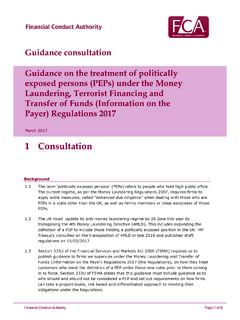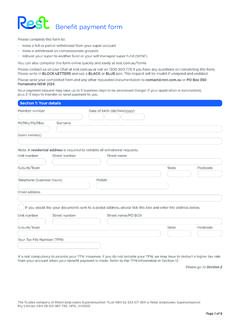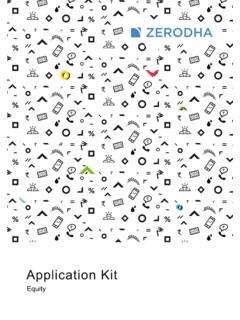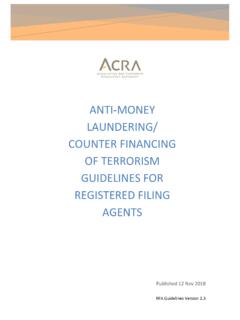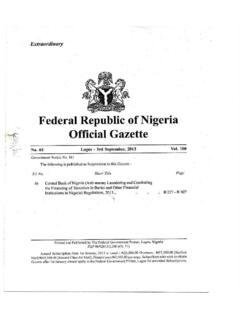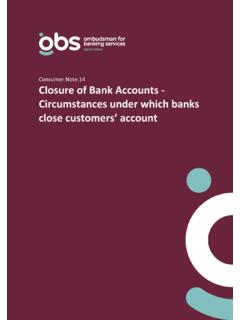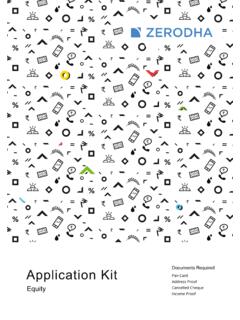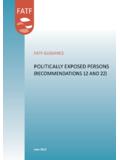Transcription of GUIDANCE FOR A RISK-BASED APPROACH - FATF-GAFI.ORG
1 GUIDANCE FOR A RISK-BASED APPROACH ACCOUNTING PROFESSION JUNE 2019 The Financial Action Task Force (FATF) is an independent inter-governmental body that develops and promotes policies to protect the global financial system against money laundering, terrorist financing and the financing of proliferation of weapons of mass destruction. The FATF Recommendations are recognised as the global anti-money laundering (AML) and counter-terrorist financing (CFT) standard. For more information about the FATF, please visit This document and/or any map included herein are without prejudice to the status of or sovereignty over any territory, to the delimitation of international frontiers and boundaries and to the name of any territory, city or area.
2 Citing reference: FATF (2019), RISK-BASED APPROACH for the Accounting Profession, FATF, Paris, 2019 FATF/OECD. All rights reserved. No reproduction or translation of this publication may be made without prior written permission. Applications for such permission, for all or part of this publication, should be made to the FATF Secretariat, 2 rue Andr Pascal 75775 Paris Cedex 16, France (fax: +33 1 44 30 61 37 or e-mail: Photocredits coverphoto Getty Images GUIDANCE FOR A RISK-BASED APPROACH FOR THE ACCOUNTING PROFESSION 1 2019 | FATF Table of contents Acronyms .. 3 Executive Summary .. 5 Section I - Introduction and key concepts.)
3 7 Background and context .. 7 Purpose of the GUIDANCE .. 8 Target audience, status and content of the GUIDANCE .. 8 Scope of the GUIDANCE and key features of the accountancy profession .. 9 Scope and Terminology .. 9 Key features .. 10 Vulnerabilities of accounting services .. 11 FATF Recommendations applicable to accountants .. 13 Section II The RBA to AML/CFT .. 14 What is the RISK-BASED APPROACH ? .. 14 The rationale for the new APPROACH .. 15 Application of the RISK-BASED APPROACH .. 15 Challenges .. 16 Allocating responsibility under a RBA .. 19 Identifying ML/TF risk .. 19 Assessing ML/TF risk .. 20 Mitigating and managing ML/TF risk.
4 20 Developing a common understanding of the RBA .. 21 Section III: GUIDANCE for accountants on implementing a risk-b ased APPROACH .. 22 Risk identification and assessment .. 22 Country/Geographic risk .. 24 Client risk .. 25 Transaction/Service and associated delivery channel risk .. 29 Variables that may i mpact on a RBA and on risk .. 32 Documentation of risk assessments .. 33 Risk mitigation .. 33 Initial and ongoing CDD ( and 22) .. 34 politically exposed persons (PEP) ( and ) .. 38 Ongoing monitoring of clients and specified activities ( and 22) .. 39 Suspicious activity/transaction reporting, tipping-off, internal controls and higher-risk countries ( ).
5 40 Section IV GUIDANCE for supervisors .. 44 RISK-BASED APPROACH to supervision .. 44 2 GUIDANCE FOR A RISK-BASED APPROACH FOR THE ACCOUNTING PROFESSION 2019 | FATF Supervisors and SRBs role in supervision and monitoring .. 44 Understanding ML/TF risk .. 45 Mitigating and managing ML/TF risk .. 46 Supervision of the RBA .. 48 Licensing or registration .. 48 Monitoring and supervision .. 50 Enforcement .. 51 GUIDANCE .. 52 Training .. 52 Endorsements .. 53 Information exchange .. 53 Supervision of Beneficial Ownership requirements and source of funds/wealth requirements .. 54 Nominee arrangements .. 56 Annex 1: Beneficial ownership information in relation to a trust or other legal arrangements to whom an accountant provides services.
6 58 Annex 2: Glossary of terminology .. 63 Annex 3: Supervisory practices for implementation of the RBA .. 66 Annex 4: Members of the RBA Drafting Group .. 69 GUIDANCE FOR A RISK-BASED APPROACH FOR THE ACCOUNTING PROFESSION 3 2019 | FATF Acronyms AML/CFT Anti-money laundering/Countering the financing of terrorism CDD Client1 due diligence DNFBP FATF FIU Designated non-financial businesses and professions Financial Action Task Force Financial intelligence unit INR. Interpretive Note to Recommendation ML NRA Money laundering National Risk Assessment PEP politically exposed Person R. Recommendation RBA RISK-BASED APPROACH SRB STR Self-regulatory body Suspicious transaction report TCSP TF Trust and company service providers Terrorist financing 1 In some jurisdictions or professions, the term customer is used, which has the same meaning as client for the purposes of this document.
7 4 GUIDANCE FOR A RISK-BASED APPROACH FOR THE ACCOUNTING PROFESSION 2019 | FATF GUIDANCE FOR A RISK-BASED APPROACH FOR THE ACCOUNTING PROFESSION 5 2019 | FATF Executive Summary 1. The RISK-BASED APPROACH (RBA) is central to the effective implementation of the FATF Recommendations. It means that supervisors, financial institutions, and professional accountants in public practice (also referred to as accountants or accountancy profession for the purpose of this GUIDANCE ) identify, assess, and understand the money laundering and terrorist financing (ML/TF) risks to which they are exposed , and implement the most appropriate mitigation measures.
8 This APPROACH enables them to focus their resources where the risks are higher. 2. The FATF RBA GUIDANCE aims to support the implementation of the RBA, taking into account national ML/TF risk assessments and AML/CFT legal and regulatory frameworks. It includes a general presentation of the RBA and provides specific GUIDANCE for the accountancy profession and for their supervisors. The GUIDANCE was developed in partnership with the profession, to make sure it reflects expertise and good practices from within the industry. 3. The development of the ML/TF risk assessment is a key starting point for the application of the RBA.
9 It should be commensurate with the nature, size and complexity of the business. The most commonly used risk criteria are country or geographic risk, client risk, service/transaction risk. The GUIDANCE provides examples of risk factors under these risk categories. 4. The GUIDANCE highlights that it is the responsibility of the senior management of accountants to foster and promote a culture of compliance as a core business value. They should ensure that accountants are committed to manage ML/TF risks when establishing or maintaining business relationships. 5. The GUIDANCE highlights that accountants should design their policies and procedures so that the level of initial and ongoing client due diligence measures addresses the ML/TF risks they are exposed to.
10 In this regard, the GUIDANCE explains the obligations for accountants regarding identification and verification of beneficial ownership information and provides examples of standard, simplified and enhanced CDD measures based on ML/TF risk. 6. The GUIDANCE has a section for supervisors of the accountancy profession and highlights the role of self-regulatory bodies (SRBs) in supervising and monitoring. It explains the RISK-BASED APPROACH to supervision as well as supervision of the RISK-BASED APPROACH by providing specific GUIDANCE on licensing or registration requirements for the accountancy profession, mechanisms for on-site and off-site supervision, enforcement, GUIDANCE , training and value of information-exchange between the public and private sector.










